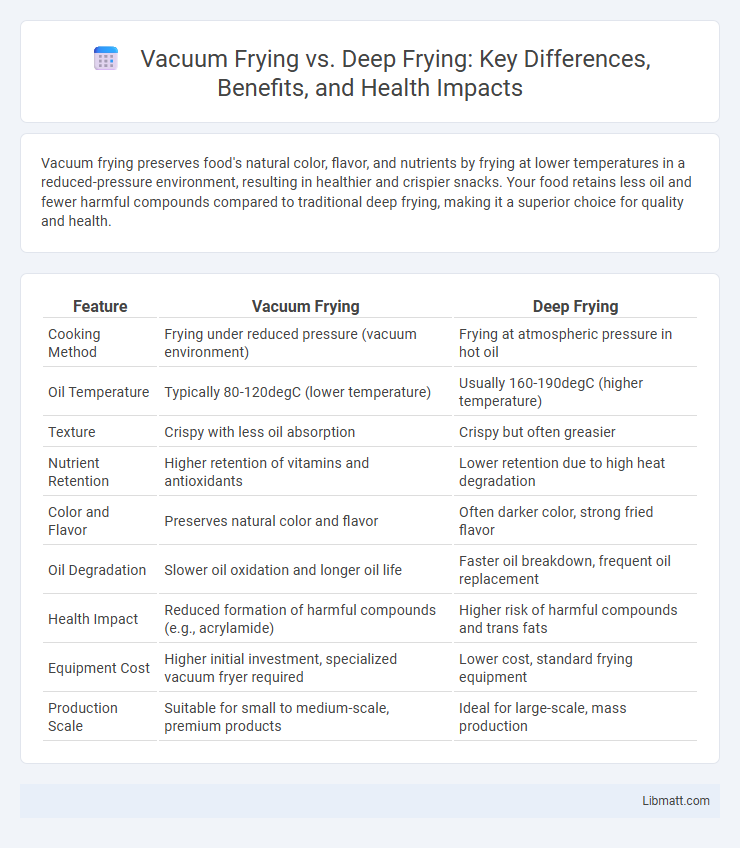Vacuum frying preserves food's natural color, flavor, and nutrients by frying at lower temperatures in a reduced-pressure environment, resulting in healthier and crispier snacks. Your food retains less oil and fewer harmful compounds compared to traditional deep frying, making it a superior choice for quality and health.
Table of Comparison
| Feature | Vacuum Frying | Deep Frying |
|---|---|---|
| Cooking Method | Frying under reduced pressure (vacuum environment) | Frying at atmospheric pressure in hot oil |
| Oil Temperature | Typically 80-120degC (lower temperature) | Usually 160-190degC (higher temperature) |
| Texture | Crispy with less oil absorption | Crispy but often greasier |
| Nutrient Retention | Higher retention of vitamins and antioxidants | Lower retention due to high heat degradation |
| Color and Flavor | Preserves natural color and flavor | Often darker color, strong fried flavor |
| Oil Degradation | Slower oil oxidation and longer oil life | Faster oil breakdown, frequent oil replacement |
| Health Impact | Reduced formation of harmful compounds (e.g., acrylamide) | Higher risk of harmful compounds and trans fats |
| Equipment Cost | Higher initial investment, specialized vacuum fryer required | Lower cost, standard frying equipment |
| Production Scale | Suitable for small to medium-scale, premium products | Ideal for large-scale, mass production |
Introduction: Understanding Frying Methods
Vacuum frying preserves the natural color, flavor, and nutrients of food by frying at lower temperatures in a reduced oxygen environment, minimizing acrylamide formation and oxidation. Deep frying involves submerging food in hot oil at high temperatures, which can lead to higher oil absorption and nutrient degradation but offers a crispy texture and faster cooking times. Your choice between vacuum frying and deep frying affects the healthiness, taste, and texture of the final product based on cooking method and temperature.
What is Vacuum Frying?
Vacuum frying is a food processing method that involves frying at lower temperatures under reduced pressure, which minimizes oil absorption and preserves the natural color, flavor, and nutrients of the food. This technique is particularly effective for delicate products like fruits and vegetables, preventing oxidation and thermal degradation. In contrast to traditional deep frying at atmospheric pressure, vacuum frying enhances product quality while reducing harmful compounds formed during frying.
What is Deep Frying?
Deep frying is a cooking method where food is submerged in hot oil, typically between 350degF and 375degF (175degC to 190degC), allowing rapid heat transfer that crisps the exterior while cooking the interior. This process causes Maillard reaction and caramelization, enhancing flavor and texture, but often results in higher oil absorption and calorie content. Commonly used for foods like french fries, chicken, and doughnuts, deep frying requires oil with a high smoke point such as peanut or canola oil for optimal results.
Key Differences Between Vacuum Frying and Deep Frying
Vacuum frying operates at lower temperatures under reduced pressure, preserving nutrients and colors by minimizing oil absorption and oxidation, whereas deep frying uses higher temperatures and atmospheric pressure, often resulting in greater oil uptake and nutrient degradation. The vacuum environment reduces oil-related contaminants and off-flavors, providing a healthier and more visually appealing product compared to traditional deep frying. Additionally, vacuum frying extends shelf life through reduced Maillard reactions and browning intensity, contrasting with the darker, crispier texture typical in deep-fried foods.
Nutritional Comparison of Vacuum and Deep Frying
Vacuum frying preserves more nutrients in foods by operating at lower temperatures, reducing the degradation of heat-sensitive vitamins like vitamin C and antioxidants compared to deep frying. Your meals retain higher levels of natural flavor and color due to minimal oxidation during the vacuum frying process. Deep frying, however, often leads to increased oil absorption and nutrient loss, resulting in less healthy food options.
Impact on Food Texture and Flavor
Vacuum frying preserves food texture by reducing oil absorption and maintaining crispness due to lower frying temperatures and reduced oxygen exposure. This method enhances natural flavors and colors by inhibiting oxidation and Maillard reaction overdevelopment, resulting in a fresher taste profile. In contrast, deep frying often produces a greasier texture and can impart stronger, sometimes burnt flavors because of higher temperatures and prolonged oil contact.
Oil Absorption: Which Method is Healthier?
Vacuum frying significantly reduces oil absorption compared to deep frying by frying foods at lower temperatures under reduced pressure, resulting in healthier, less greasy products. This method preserves natural nutrients and flavor while decreasing harmful compounds such as acrylamide, often formed during high-temperature deep frying. Choosing vacuum frying over traditional deep frying leads to lower fat content and improved nutritional quality of fried foods.
Industrial and Home Applications
Vacuum frying offers superior oil retention and nutrient preservation compared to deep frying, making it ideal for industrial-scale production of healthier snack foods with extended shelf life. Home applications of vacuum frying remain limited due to higher equipment costs and complexity, whereas deep frying maintains widespread use for its simplicity and affordability. In industrial settings, vacuum frying enhances product quality by reducing acrylamide formation and oxidation, whereas deep frying is favored for rapid cooking and equipment accessibility.
Cost and Equipment Considerations
Vacuum frying requires specialized equipment with vacuum chambers and precise temperature controls, leading to higher initial investment and maintenance costs compared to traditional deep frying setups. Operating expenses may be reduced due to lower oil degradation and extended oil life in vacuum frying, potentially balancing long-term costs. Evaluating your production scale and budget is crucial when deciding between the costlier vacuum frying technology and the widely available, less expensive deep frying equipment.
Conclusion: Choosing the Right Frying Method
Vacuum frying preserves nutrients and reduces oil absorption by frying at lower temperatures under reduced pressure, making it ideal for healthier, high-quality snacks. Deep frying offers faster cooking times and crisp texture but often results in higher oil content and potential nutrient loss. Selecting the right method depends on prioritizing health benefits, texture preferences, and production efficiency for specific food products.
Vacuum Frying vs Deep Frying Infographic

 libmatt.com
libmatt.com